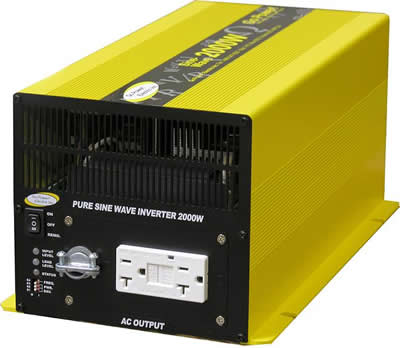
| No. | Proteus Tutorials |
|---|---|
| Give Your Suggestions !!! | |
| 1. | Basics of Inverters With Topology |
| 2. | Major Components of Inverter |
| 3. | Pure Sine Wave Inverter Design With Code |
| 4. | Modified Sine Wave Design With Code |
Hello guys, in the last post I have explained the basics of inverters along with its types and also the inverters topology in other words working of inverters. Now in this post I am gonna explain the major components required for making an inverter. This post is not giving you any technical knowledge about inverter but to workout with inverters its necessary to go through its basic components.
I have divided this tutorial into four parts which are shown below. This is a step by step guide to design and build an inverter and I hope at the end of this tutorial you guys will be able to design your own inverter. I tried my best to keep it simple but still if you guys got stuck at any point ask in comments and I will remove your query.
Major components of an inverter
- An inverter design and components vary with requirements but following components are most commonly used in designing an inverter.
Microcontroller
- Microcontroller is the main and integral part of an inverter. The main working of microcontroller is to control the switching of signals according to the requirements.
- A single microcontroller can perform multiple functions (e.g.) generating PWM for switching, controlling the protection systems etc.
- There are various types and families of microcontrollers available in the market, for example :
- PIC Microcontrollers.
- AVRs (ATMEGA series).
- Atmel.
- Arduino.
- FPga (etc).
- 8051 Microcontrollers Projects.
- Depending on the design specifications, any microcontroller can be used.
Bipolar junction transistors (BJTs)
- BJT or a bipolar junction transistor is a three layered device which is capable of controlling the current flow.
- In a BJT, a small current at the input of the device can control larger currents at the output. Thus, BJTs can amplify currents.
- They can be used as a relay driver, as a switch, as a constant current source, as an amplifier (etc.).
- Circuit symbol of a BJT is given in figure below :
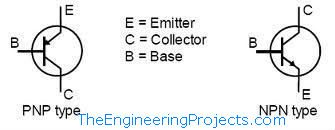
Types of BJTs
- There are two types of transistors, NPN and PNP transistors
- NPN is one of the two types of bipolar transistors, in which the letters "N" and "P" refer to the majority charge carriers inside the different regions of the transistor.
- In other terms, an NPN transistor is "on" when its base is pulled high relative to the emitter.
- The arrow in the NPN transistor symbol is on the emitter leg and points in the direction of the conventional current flow when the device is in forward active mode.
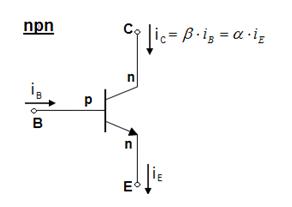
- PNP transistors have two layers of P-doped material and in between these two layers, there's a small layer of N-doped material.
- A small current leaving the base in common-emitter mode is amplified in the collector output. In other terms, a PNP transistor is "on" when its base is pulled low relative to the emitter.
- The arrow in the PNP transistor symbol is on the emitter leg and points in the direction of the conventional current flow when the device is in forward active mode.
- Below figure shows both NPN and PNP transistors.
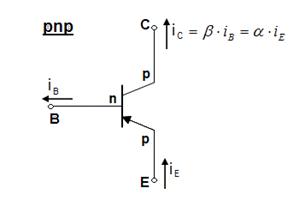
H-Bridge
- H –bridge is a topology in which four switching devices BJTs, MOSFETs or IGBTs are integrated together in a single circuit.
- The name H-Bridge is given to it because of the typical arrangement of this circuit.
- Mainly used switching devices in the H-bridge circuits are BJTs, MOSFETs or IGBTs.
Working
- In an H-bridge, corresponding to the figure below when the switches S1 and S4 are closed, the switches S2 and S3 are open.
- Thus a positive voltage issupplied across the motor or any other load attached to it instead of motor (e-g) transformer.
- When S1 and S4 switches are opened, and S2 and S3 switches are closed, the voltage is reversed, supplying negative voltages to the load.
- A problem with this is that the switches S1 and S2 should never be closed at the same time, as this causes a short circuit on the input voltage source.
- The same thing applies on the switches S3 and S4. This condition is generally known as the shoot-through condition.
- Following figure describes the above phenomena.

MOSFETs
- The Metal-Oxide-Semiconductor-Field-Effect-Transistor (MOSFET) is a voltage controlled device and requires a very small input current.
- It is mainly used for switching of electronic signals as its switching speed is very high.
- It is the most commonly used FET in low-power high-frequency circuits.
- The MOSFET is composed of a channel of n-type or p-type semiconductor material, and is accordingly called an N-MOSFET or a P-MOSFET.
- Circuit symbols of MOSFET are shown in the figure below :
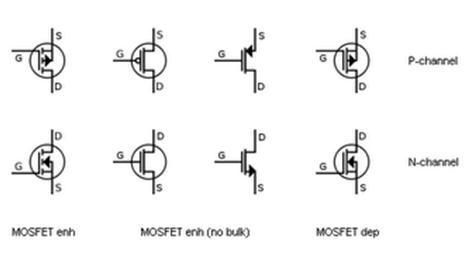
Types of MOSFETs
There are two main types of MOSFETs.- The Depletion-type MOSFET (DMOSFET)
- Enhancement-type MOSFET (E-MOSFET)
Filters
- At times it is desirable to have circuits capable of selectively filtering one frequency or range of frequencies out of a mix of different frequencies in a circuit.
- A circuit designed to perform this frequency selection is called a filter circuit.
Low-Pass Filters
- A low-pass filter is a circuit offering easy passage to low-frequency signals and difficult passage to high-frequency signals.
- There are two basic kinds of circuits capable of accomplishing this objective, and many variations of each one.
LC Filters
- An LC filter is a low-pass filter which consists of an inductor attached in parallel with the capacitor and the load.L and C connected together act asan electrical resonator.
LC Filter over RC Filter
- RC filters have R thus they dissipate power. They have attenuation even in the pass band.
- To achieve a narrow transition band, RC circuits have to be of higher orders.
- Only certain types of filters can be implemented by an RC filter.
- Whereas, LC filter does not dissipate power.
- Better characteristics can be achieved by the LC filter than RC with a lower order.
- Thus it is desirable to choose an LC over an RC in the case of an inverter.
Transformer
- A transformer is used to step up or step down the electrical voltages.

Working of Transformer
- A changing electric flux in the primary of the transformer creates a changing magnetic field which induces a changing voltage in the secondary.
- By adding load, one can transfer energy from one part to another.
- The secondary voltage Vs of an ideal transformer is scaled from the primary voltage Vpby a factor equal to the ratio of the number of turns of wire in their respective windings.
- By appropriate selection of the numbers of turns, a transformer thus allows an alternating voltage to be stepped up by making Ns more than Np or stepped down,by making it less.
- If the secondary coil is attached to a load that allows current to flow, electrical power is transmitted from the primary circuit to the secondary circuit.
- Ideally,
- Pin = Pout
- IpVp= IsVs
- Where:
- Pin = Input Power.
- Pout = Output Power.
- Ip = Primary Current.
- Vp = Primary Voltage.
- Is = Primary Current.
- Ip = Primary Voltage



